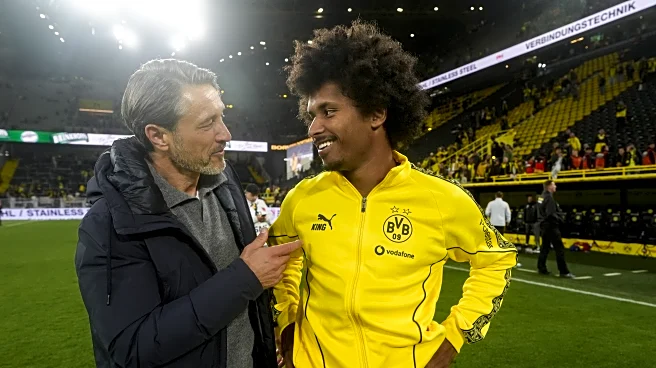When Niko Kovac arrived at Borussia Dortmund, one of his key changes to the side was a move to a three-back defensive line, which collected most of the attention. Things up front remained relatively the same, with two wingers, typically Beier and Adeyemi, flanking Serhou Guirassy. This is the attack that put three past Barcelona, and led Dortmund to a 7-0 finish to the 24/25 season. In 25/26, the three-back remains, but it seems that the role of the “wingers” has changed.
Kovac has moved his support
forwards slightly behind Guirassy into a more dynamic, center-forward role. Karim Adeyemi has been thriving in this new role, alternating between more traditional wing play to bring the attack up the field, and tucking inside to create danger around the box. Adeyemi’s constant shift between winger and striker has been difficult for teams to track and defend, and is what BVB should be aiming for to get the most out of this formation. So, what about the other five attackers?
There are two spots behind Serhou Guirassy (or Fabio Silva), and those need to be filled by any of these talented individuals: Karim Adeyemi, Maxi Beier, Julian Brandt, Carney Chukwuemeka, Cole Campbell, and Julien Duranville. What is unique about Niko Kovac’s system is that it could be any of them, at any time. Likely (hopefully), this was his plan; a dynamic attacking position to allow a variable cast of attackers to rotate in and interpret the position as best fits their style of play. If we have aren’t going play a CAM or a winger, we need our attackers to be both a CAM and a winger.
This may not work for everyone. So far, despite all suggestions that this role is practically tailor-made for Maxi Beier, the former Hoffenheim man has not had nearly as much success in it as Adeyemi. This came as quite a surprise, as the dynamic forward role is similar to Beier’s role in Sinsheim. Beier has not been dreadful, but I expected that he, with the support of the tireless Daniel Svensson, would be able to create a lot of danger down the left hand side.

Julian Brandt has been fairly successful. Brandt has never been my favorite winger, despite being shuttled out to the byline by a myriad of Dortmund coaches over the years. In Kovac’s system, Brandt can remain more central as is his preference, and leave the wide play to Svensson. This has allowed him to work his way back into the coach’s trust with a series of good performances.
As for the other attackers at Kovac’s disposal… the jury is out. Carney Chukwuemeka has not had enough minutes to suggest that he is ready to unseat Beier, and Dortmund’s true wingers, Campbell and Duranville, are either injured or have not been given a sniff of the pitch so far. That said, I would really like to see what Campbell can do in this attack. He is a very direct, goal-minded winger, and could help BVB with some high energy play at the end of a match. Chukwuemeka has the quickness and ball control to move between the CAM and winger space seamlessly, and while he is not blisteringly quick like Adeyemi, his ball control and interplay allow him to work up the field as a ball carrier. Duranville has obvious quality, but I question his ability to link up with teammates and serve in the creator’s role that is required of a CAM. Hard to say at this point.
Kovac has done well to create an attack that suits the diverse cast at his disposal. What will be most important as the season goes forward is figuring out the pairings, how they work together on the pitch, and which pairs of players need to be together at which stages of the match. Perhaps an Adeyemi-Beier pairing is the stable option for 60 minutes, while a Brandt-Chukwuemeka pairing subs in to control and see out the match. Or, if Dortmund are behind, swap to Duranville-Adeyemi and go direct at the opponent in a winger system. If Kovac can customize his attacking strategy on the fly with pre-built, interchangeable pairings of players, Dortmund could be a very difficult attacking side to predict and defend this season.















